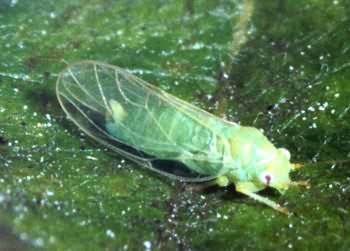Pests
Psylla mali Schmidberger - Apple Sucker
Systematic position.
Class Insecta, order Homoptera, family Psyllidae, subfamily Psyllinae, tribe Psyllini, genus Psylla.Biological group.
This is a monophagous pest of apple-trees.Morphology and biology.
Body of apterous female is blue-green, later yellow; in autumn it is red. Its length reaches to 3 mm. The insect has brown femora, yellow tarsi and tibiae. Antenna is brown, filiform, with two bristles at the end. Thorax is also brown, with white spots and five yellow longitudinal strips on the back. Male is less bright. Larva is yellow, flat, with red eyes. Nymph is blue-green. Oval eggs are pale orange. Over-wintering takes place during the egg phase near base of buds,in bark wrinkles on young twigs of apple trees. Hatching of larvae is observed at the end of April and in the beginning of May (during the period of bud blossoming). At first they feed openly on buds and then they penetrate into buds or under scale leaves. Then the pests suck sap from leafstalks, peduncles,leaves and flower buds. Larva has five instars and five molts. The larva turn into nymphs that feed on lower side of leaves. Larval period lasts 29-44 days. Winged insects emerge 15-25 days after flower petals fall. Under hot and dry weather conditions the Apple Suckers fly to grasses and bushes, hiding in shady places. After coupling at the end of August the oviposition takes place. The latter lasts through September and October. Eggs are laid individually, often in groups, into the drop of hardening excretions. Female fecundity varies from 130 to 500 eggs. The oviposition lasts up to 35 days, embryonic development lasts up to 10-21 days.Distribution.
The insect is widespread in North and Central Europe, in North America. Within the territory of the Former Soviet Union the northern border of area passes across Baltic States and Leningrad region; southern border goes along the following line: Kishinev (Chisinau) - Dnipropetrovsk - Volgograd. High levels of harm appear in the lower northern and middle zones of fruit-growing. Southern zone of high damage passes along the following line: Kam.yanets-Podil.skii - Vinnytsya Kiev - Kharkiv - Voronezh - Kuibyshev.Ecology.
The pest wintering phase is cold-resistant; however, frequent alternation of frosts and thaws has a bad effect on eggs. During late spring frosts a considerable extent of larva death is marked. The most favorable conditions for insects are moderate temperatures (18-20°C) and high relative humidity (70-80%). Oviposition takes place most successfully at temperatures of 12-15°C, but no less than 10°C. The species produces only one generation during a year. Most important predators include Propylaea quatuordecimpunctata L., Coccinella septempunctata L., C. quinquepunctata L., Chilocorus bipustulatus L., Ch. renipustulatus L., Anatis ocellata L., Adalia bipunctata L., Adonia variegata Gz., Calvia quatuordecimguttata L., C. quinquedecimguttata F., Chrysopa carnea Steph., Chr. septempunctata Wesm., Hemerobius humulinus L., Psallus ambiguous Fall., Deraeocoris brachialis Stal., Antocoris nemorum L., Orthotylus marginalis Reut.Economic significance.
Apple Sucker causes damage to apple trees; sucking plant sap, it causes bad development, yellowing, twisting of leaves and peduncles, also falling of flowers, buds, and ovaries. This pest depresses tree development. The harvest decreases, fruits also become smaller. Insects secrete sweet sticky excretions. These excretions pollute leaves, plug up stomata; the leaves are covered with soot dew. Control measures include use of tobacco dust and fumigation; early spring treatment (during bud hibernation) with ovicides; later destruction of females and larvae by insecticides.Reference citations:
Bezdenko T.T., Osipov V.T., Polyakova T.E. 1975. The significance of entomophages in apple sucker population lowering. In: Skarapanau S.G., ed. Vestsi Akademii navuk BSSR 1: 65-70. (In Russian)Borisoglebskaya M.S. 1969. Apple sucker. Zashchita rastenii, 2: 43. (In Russian)
Novopol'skaya E. 1940. New dates on biology of apple sucker in Crimea. In: Kulagin N.M., ed. Vestnik Zashchity rastenii. N. 1-2. Leningrad: VIZR. 96-9 p. (In Russian)
Pokrovskii E.A. 1925. Apple sucker and its control. Proceedings of plant protection station from pests of Moscow land department. Moscow. 5 p. (In Russian)
Popov S.Ya. 1995. Apple sucker. Zashchita rastenii, 5: 25-6. (In Russian)
Ramakaev Kh.Kh. 1979. Some biological features of apple sucker Psylla mali Schmd. in forest-park conditions of Kharkiv city. In: Naumov G.F., ed. Proceedings of Kharkiv Agricultural Institute. V. 259. Kharkiv: Kharkiv Agricultural Institute. 64-7 p. (In Russian)
Savkovskii P.P. 1976. Apple sucker. Zashchita rastenii, 2: 58. (In Russian)
Sem'yanov V.P. 1973. Entomophages of apple sucker and ways of its significant increase. Zashchita rastenii, 5: 19. (In Russian)
Smol'yannikov V.V. 1972. Apple sucker. Zashchita rastenii, 1: 24-7. (In Russian)
Sokol'nikova N.V. 1979. Harmfulness of apple sucker in the North-Western zone of RSFSR. In: Novozhilov K.V., ed. Injuriousness of insect pests and diseases of agricultural crops. Proceedings of VIZR. Leningrad: VIZR. 67-79 p. (In Russian)
Sokol'nikova N.V. 1980. Studying of apple sucker harmfulness. Zashchita rastenii, 12: 46-7. (In Russian)
Titov D.A. 1992. Main methods of pests and diseases monitoring on fruit cultures. Zashchita rastenii, 2: 42-4. (In Russian)
Tret'yakov N.N. 1984. Biological basis of control measures against apple bud Anthonomus pomorum L. and apple sucker Psylla mali Schmdbg. at passage to integrated control of fruit garden. PhD Thesis. Moscow: TSKhA. 16 p. (In Russian)
Vasil'ev V. 1926. Apple sucker (Psylla mali Forst.). In: Vasil'ev V., ed. Proceedings of department of plant protection from agricultural pests of Narkozem of Volga-German ASSR. 4 p. (In Russian)


